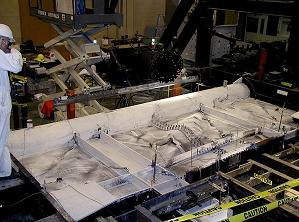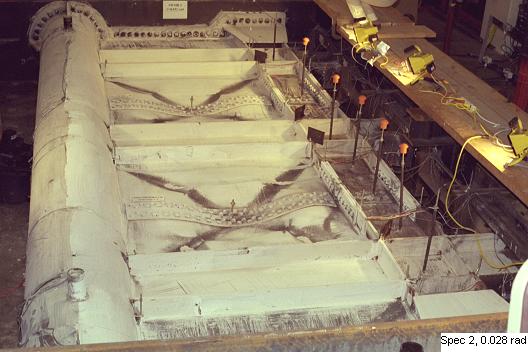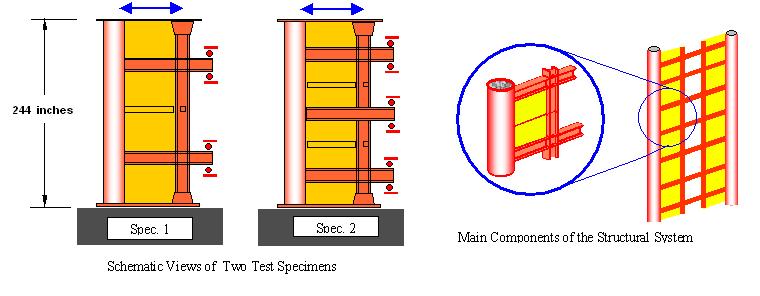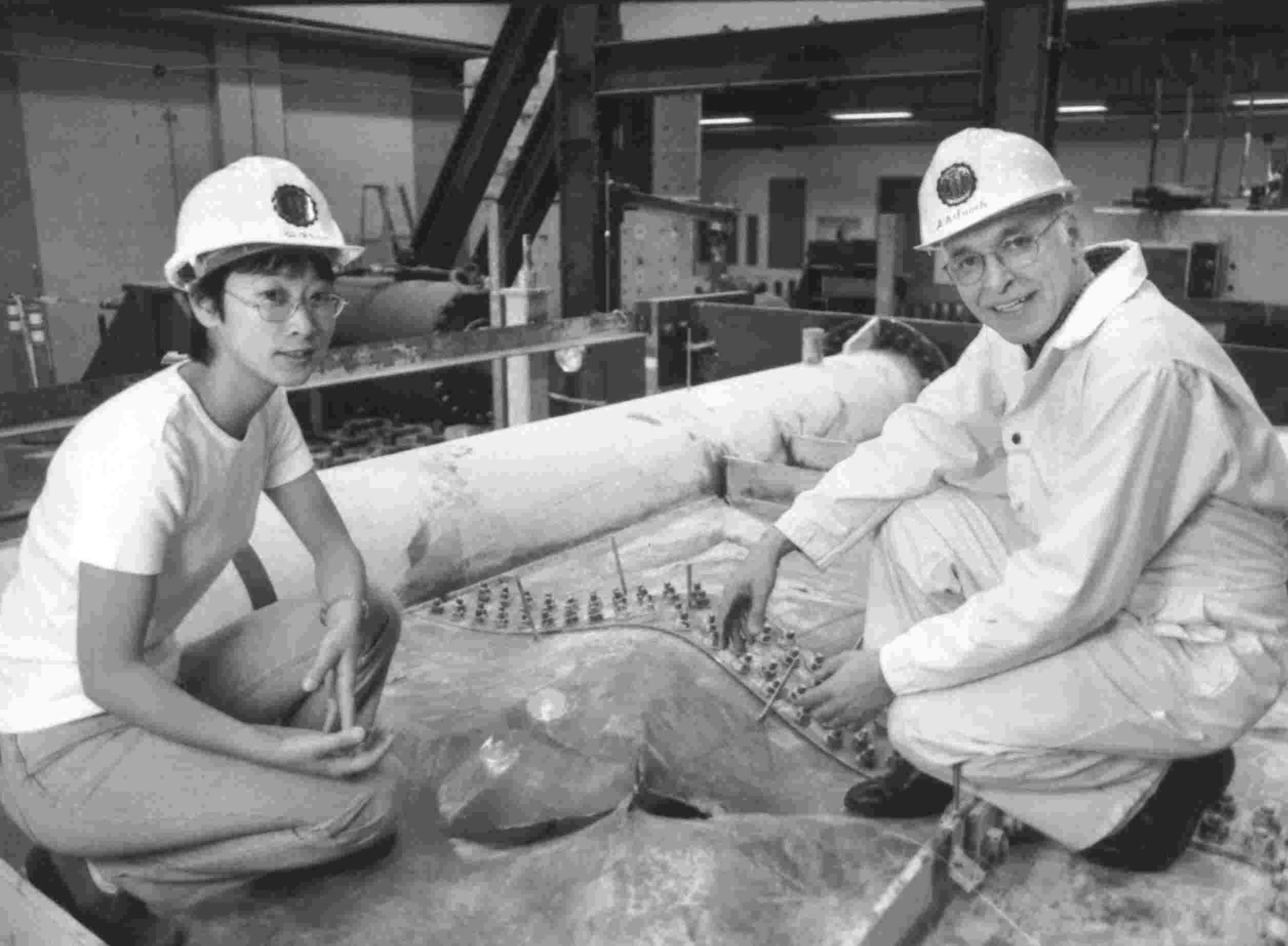|
Please send your comments to A. Astaneh-Asl at astaneh@ce.berkeley.edu Steel
Shear Walls Abolhassan
Astaneh-Asl, Ph.D., P.E. (Principal Investigator) Deaprtment of Civil
and Environmental Engineering Sponsor: General Services Administration and MKA |
ABSTRACT
Cyclic Behavior and Seismic Design of Steel Shear Walls
A. Astaneh-Asl and Q. Zhao
University of California, Berkeley, California, USA
In this research and development project, two steel shear wall specimens were subjected to realistic cyclic loads simulating the effects of strong earthquakes. The main objectives were to establish cyclic stiffness, strength, ductility, energy dissipation characteristics and failure modes for these two specimens. An added objective was to use the test results and to develop design-oriented information on seismic design of systems similar to the specimens tested. Of particular interest was to establish Response Modification Factor, Over-strength Factor, and Displacement Magnification Factor which would all be needed if using the current seismic design code procedures. Two specimens were tested. Both specimens had a total height of 20 feet-4 inches (6.2 meters) and a center to center column distance of 7 feet. Specimen One had one full story with two ½-stories above and below the full story. Specimen Two had two full stories and two ½-story above and below the two-story portion. Both specimens were subjected to the same cyclic horizontal displacement time histories by applying a cyclic horizontal force at the top of specimens. The test results were used to establish shear-force drift hysteresis loops as well as other cyclic behavior parameters. More information on the project can be found in the Final Report and the Executive Summary.
Specimen One, which had taller steel shear walls with height-to width ratio of 1.5, yielded at a drift value of about 0.0065. The specimen showed very high cyclic ductility and was able to reach cyclic inter-story drift of about ± 3.3% after undergoing 79 cycles, 39 of the cycles being inelastic. The maximum shear force reached was about 917 kips during the 79th cycle. Behavior of this specimen was very ductile. Throughout the test, the gravity load carrying concrete filled steel tube remained essentially elastic while non-gravity carrying lateral load resisting elements underwent well-distributed and desirable yielding. The specimen failed during 80th cycle due to fracture of the top coupling beam due to low-cycle fatigue fracture of the web.
Similar to Specimen One, Specimen Two also behaved in a ductile and desirable manner. Up to inter-story drifts of about 0.7%, the specimen was almost elastic. At this drift level some yield lines appeared on the wall plate and the force-displacement curve started to deviate from the straight elastic line. During later cycles a distinct X-shaped yield line was clearly visible on the steel plate shear. The specimen could tolerate 79 cycles, out of which 35 cycles were inelastic. The specimen reached an inter-story drift of more than 3.0% and maximum shear force of 1,225 kips. At this level of drift, the upper floor-coupling beam fractured at the face of the column (due to low-cycle fatigue) and the shear strength of the specimen dropped to less than 80% of the maximum shear force reached in previous cycles (1,225 kips). Using the observed behavior of specimens and the test data, the following values for seismic design parameters were recommended for this system:
a. Response Modification Factor: 8.0
b. Over-strength Factor: 2.5
c. Displacement Amplification Factor: 4.0
It was also concluded that equations that are currently (2002) prescribed by the AISC Specification for design of plate girders can be used for design of steel shear walls.
 |
 |
|
9. Astaneh-Asl, A.,(2002) "Cyclic
Tests and Seismic Design of Steel Shear Wall Systems",
Executive Summary of the Project", Dept. of Civil and Environmental
Engineering, Univ. of California, Berkeley, July.(This publication
is not in public domain.)
8. Astaneh-Asl, A., and Zhao, Q.,
(2002), "Cyclic Tests of Steel Shear Walls, Volume I-Final Report ",
Final Report to the Sponsors, Report Number UCB/CEE-STEEL-01/01, Dept. of
Civil and Env. Engineering, Univ. of California, Berkeley, July. (To purchase
a copy of this publication please see above note.)
7. Astaneh-Asl, A., and Zhao, Q., (2002a), "Cyclic Tests of Steel Shear
Walls, Volume II-Appendices to Final Report", Final Report to the Sponsors,
Report Number UCB/CEE-STEEL-01/01a, Dept. of Civil and Env. Engineering,
Univ. of California, Berkeley, July. (This publication is not in public
domain.)
6. Astaneh-Asl, A., (2001), " Seismic
Behavior and Design of Steel Shear Walls,
Steel TIPS Report, Structural Steel Educational Council, CA, January. (Click
on the title to get a free copy of this publication).
5. Astaneh-Asl, A., and Zhao, Q., (2002) "Cyclic Behavior of Steel
Shear Wall Systems", Proceedings, 2002 Annual Stability Conference,
Structural Stability Research Council, In Connection with the the AISC North
American Steel Construction Conference, April 25-27, Seattle. (Contact
SSRC at http://www.ce.ufl.edu/~ssrc/
for proceedings)
4. Astaneh-Asl, A., (2001), "Proposed
Tentative Seismic Design Provisions for Steel Shear Walls",
Appendix to SEAONC Seminar Paper (following item), Nov.(Click on
the title to get a free copy of this publication for personal use).
3. Astaneh-Asl, A., (2001), "Seismic
Behavior and Design of Steel Shear Walls-SEAONC Seminar",
Paper Distributed and presented at the 2001 SEOANC Seminar, Structural
Engineers Assoc. of Northern California, November 7, 2001, San Francisco.(Click
on the title to get a free copy of this publication for personal use).
2. Astaneh-Asl, A., (2001), " Cyclic Tests of Steel Shear Walls- Interim
Report on Summary of Cyclic Tests Results
Specimen UCB/SWMB/GSA-1 ", Report to Sponsors: General Services Administration
and Skilling Ward Magnusson Barkshire, Nov. (This publication is not in
public domain).
1. Astaneh-Asl, A., (2000), "Steel
Plate Shear Walls", Proceedings, U.S.-Japan Partnership
for Advanced Steel Structures, U.S.-Japan Workshop on Seismic Fracture Issues
in Steel Structures, February 2000, San Francisco.(Click on the title to
get a free copy of this publication for personal use).
0. Astaneh-Asl, A., (1999), "Cyclic Tests of Steel Shear Walls",
Proposal submitted to Sponsors: General Services Administration and Skilling
Ward Magnusson Barkshire. (This publication is not in public domain).
|
Qiuhong Zhao and Abolhassan
Astaneh-Asl |
The research reported herein was conducted in the Department of Civil and Environmental Engineering of the University of California, Berkeley and was sponsored by the General Services Administration of US Federal Government and Skilling Ward Magnusson Barkshire, Civil and Structural engineers, Seattle. The opinions expressed here are those of the authors and do not necessarily reflect the views of the University of California, Berkeley, the Sponsors or other agencies and individuals whose names appear here.
The information presented here
has been prepared in accordance with recognized engineering principles and
is for general information only. While it is believed to be accurate, this
information should not be used or relied upon for any specific application
without competent professional examination and verification of its accuracy,
suitability, and applicability by a licensed professional engineer, designer
or architect. The publication of the material contained herein is not intended
as a representation or warranty on the part of any person or agency named
herein, that this information is suitable for any general or particular
use or of freedom from infringement of any patent or patents. Anyone making
use of this information assumes all liability arising from such use. Caution
must be exercised when relying upon specifications and codes developed by
others and incorporated by reference herein since such material may be modified
or amended from time to time subsequent to the posting of this material.
The authors bear no responsibility for such material other than to refer
to it and incorporate it by reference at the time of the initial posting
of this document.
Astaneh-Asl, A., (2001), " Seismic Behavior and Design of Steel Shear Walls, Steel TIPS Report, Structural Steel Educational Council, CA, January.
( A copy of this report can
be downloaded free, for personal use, from AISC web page by clicking on
the underlined title of the report.)
2. Astaneh-Asl, A., and Zhao,
Q., (2002), "Cyclic Tests of Steel Shear Walls, Volume I-Final Report
", Final Report to the Sponsors, Report Number UCB/CEE-STEEL-01/01,
Dept. of Civil and Env. Engineering, Univ. of California, Berkeley, July.
1. Astaneh-Asl, A., and Zhao, Q., (2002), "Cyclic Tests of Steel Shear
Walls, Volume II-Appendices to Final Report", Final Report to the Sponsors,
Report Number UCB/CEE-STEEL-01/01a, Dept. of Civil and Env. Engineering,
Univ. of California, Berkeley, July. (This report is not available to general
public through this website. To obtain a copy, please contact astaneh@ce.berkeley.edu)

